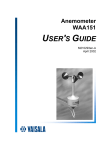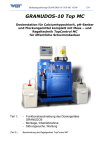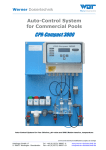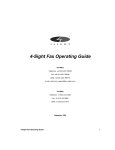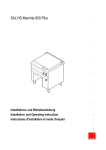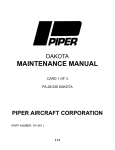Download Operating instructions PAKDOS - 60
Transcript
WDT Operating Instructions PAKDOS 60 (V61-04/06) Operating instructions PAKDOS - 60 page 1 von 22 WDT Operating Instructions PAKDOS 60 (V61-04/06) page 2 von 22 Table of Content page 2 1. Function 2. 2.1 2.2 2.3 2.4 2.4.1 2.4.2 2.5 Technical description Framework with drum carrier Powder dosing head Suspensions- and flushing device Control board PAK 60 Programmes Supervision / external switch off Demands to the quality of the carbon powder 3 3 4 5 6 6 7 7 3. 3.1 3.1.1 3.1.2 3.1.3 3.1.4 3.2 3.3 3.4 Mounting Installation into the water circulation Water take off before the filter Water take off behind the filter - standard Use of town water How to avoid an overflow Suspensions distribution to several filters Mounting of the water take off and suspension injection Electrical installation 9 9 9 9 10 10 10 4. 4.1 4.2 4.3 4.4 Taking into service Water flow through the flushing tank Water level adjustment Adjustment of the spraying nozzles in the suspension device Adjustment of the pump pressure switch 11 11 11 11 11 5. 5.1 5.2 5.3 5.4 Operation Drum change Adjustment of the dosing performance – Program switch on „B“ Back wash– isolation of the PAKDOS Control of the PAKDOS by a timer / SPS / performance control 12 12 13 14 14 6. 6.1 6.2 6.3 6.4 Irritations indication – LED meaning Short diagnosis Irritations identification - short Irritations identification – trouble shooting Maintenance – taking out of service 15 15 15 16 18 7. 7.1 7.2 7.3 wiring plan - fuses Connector housing dosing hopper Connector housing flushing tank Power plate with external control 18 18 18 19 8. Maintenance protocoll 21 9. Spare parts list 22 WDT 1. Operating Instructions PAKDOS 60 (V61-04/06) page 3 von 22 Function By dosing powdered activated carbon (PAC) onto the filter the concentration of unwanted and dangerous water ingredients as hydrocarbons and chlorinated hydrocarbons are reduced to about 10-20%. At diatomite filter this technique is stand of the art (DIN 19643). The dosing machine PAKDOS 60 meters the PAC by means of a dosing screw directly from the container into a suspension device, from where the suspension is conveyed to the filter system by a venturi nozzle. The high dilution of the carbon powder leads to good mixing into the raw water flow to be treated. The suspension produced in the PAKDOS can be distributed to up tu 4 filters. Basis for an effective use of the PAC to improve the water quality is a good functioning filter as to the DIN 19643. Attention! The different powder qualities neeed very often different dosing screws for good function. If there are problems, do not hesitate to contact us. 2. Technical description the dosing machine PAKDOS 60 consists of: - Frame with turnable drum carrier - Suspensions and flushing tank with Venturi nozzle and booster pump - Control unit - Water tapping device - Pneumatique valves (option) - Suspensions distribution (option) measures: space app. 60x70 cm heigh app. 146 cm weight app. 50 kg material: steel, powder coated other functional parts: PVC, PE, ABS seals: Viton, EPDM container/drum: PE – drum 60 l (Euro) filling weight 15 – 25 kg dosing perform: Typ PAK 1200: 10 – 1200 g/h Typ PAK 2500: 25 – 2500 g/h Also dependent to the powder quality Booster pump: water flow: Centrifugal pump 230 V / 0,33 kW Supply pressure : 0,2 – 2 bar counterpressure: 0 – 1,8 bar, dependent on supply pressure see para 3.1 1000 - 1500 l/h 1 2 3 4 5 6 7 8 9 drum belts for fasten drum drum ring for fasten dosing hopper dosing unit suspension unit control system locker for drum carrier supporting stand drum carrier electrique supply: mains plug 230 V +/- 6%, to be linked to filter pump, WDT 2.1 Operating Instructions PAKDOS 60 (V61-04/06) page 4 von 22 Standsäule mit Fassaufnahme The rotating drum carrier assembly (9) is fixed to the main vertical support (8). The drum (1) with PAC is fixed on the carrier assembly (6) by 2 band clamps (2). The dosing hopper (4) is fixed on the drum in place of the drum lid by use of the spanning ring (3) of the drum. The carrier with the drum is then turned through 180° to the dosing position, the chemical is dosed into the suspension system (5) where it is fully suspended and conveyed by a venturi to the filter tubing. 2.2 Dosing head 1 dosing motor 11 drum seal 2 motor holder 12 wore plate for powder activation 3 moving screw for powder activation 4 connector for dosing tube heater 13 flat spring for powder activation 5 dosing screw 14 fitting plate for powder activation 6 guide tube for dosing screw 15 solenoid knocker (not shown) 7 seal tube 16 empty switch (not shown) 8 dosing tube heated 17 connector housing 9 cover for dosing hopper 18 cover for dosing motor 10 dosing hopper The dosing head ist mounted onto the drum instead of the drum lid and fixed by using the original spanning ring for the lid. An capacitive switch indicates “drum empty” through the wall of the dosing hopper. The powder is activated by a knocker that give every some seconds a stroke to the hopper wall. To avoid condensation in the dosing tube (8) this is heated. WDT Operating Instructions PAKDOS 60 (V61-04/06) page 5 von 22 The dosing performance is adjusted to the needs of the water treatment by adjusting dosng cycles: At every start of a dosing cycle adjustable by the front switch S3 the dosing screw runs for a certain time, to be adjusted by the front switch S4. The dosing performance is very dependent on the quality of the powder. So the adjustment according to the table on page 13 is only a thumb value. But at the end we have to adjust the dosing performance according to the readings of the water quality. If the water quality is not good enough we have to dose more, is it better than wanted, we can reduce the dosing. 2.3 Suspension system For the function of the PAKDOS the pressure conditions are important. The limits are described under para „Mounting, page 7. At the standard type the suspension water comes from the circulation water behing the filter. (supply pressure min. 0,2 bar). Behind the booster pump (26) the high pressure water is distributed at the distribution part (27) via the floating valve (21) to the suspension tube (28 - through the rain nozzles 28a) and flushing water through a side nozzle at the floating valve and booster water to the venturi nozzle (25). 22a 21 28a 28 28a 21b 21a 29 32 31 22 20 31a 30 23 27 26a 20 21 21a 22 22a 23 24 25 26 26a 26b 26 pressure switch floating valve floater of floating valve flushing tank overflow filter 300 for flushing water flow switch venturi nozzle boster pump pump connector suction side 1 ¼“ with gauge connector 25 24 26b 27 28 28a 29 30 31 31a 32 pump connector pressure side 1" pressure water distribution PAK suspensor rain nozzles (2 pieces) level switch pressure washers (in union) transparant detection tube with Opto-sensor (option) gauge connector ¼“ isolation valve d25 The produced PAC-suspension is sucked off by the venturi (25) from the suspension tube. The black powder is to be seen shortly after dosing in the transparent suction tube (with the WDT Operating Instructions PAKDOS 60 (V61-04/06) page 6 von 22 flow switch 24) and the transparent detection tube with the optional available opto-sensor to monitor the dosing function. The suction power of the venturi is adjusted at taking into service by fitting a washer into the union behing the venturi nozzle: is the suction power too high, use a nozzle with smaller hole, ist the suction power too low, use one with bigger hole. A set of these washers is packed by to the machine. The pressure and flow situation is monitored by the pressure switch (20) on top of the booster pump, level switch (29) in the flushing tank and the flow switch (24) below the venturi. Dosing and also the booster pump are switched off in case of any irritations situation. The irritation is indicated by the 4 red LEDs at the front plate. The switch bobbin of the flow switch (24) functions as a non return valve to avoid a high rate backflow of suspension from the flushing tank in case of switch off. To avoid completely a backflow at switch off, e.g. at back wash of the filter, pneumatic isolation valves may be installed in the supply and dosing tube. Switching the PAKDOS through a timer watch and using the program BZ the tubing of the PAKDOS is rinsed for 1 minute without dosing to clean the tubing. 2.4 Control system The microprocessor based control system fitts three functions: - 2.4.1 Dosing and test programmes with 3 switches Functions and irritations identification by means of 1 green and 4 red LEDs If an irritation occurs, the dosing is switched off automatically Short diagnosis and function check Programmes 4 test programmes to check the set dosing performance: B 5: B10: B15: B30: dosing 5 minutes dosing 10 minutes dosing 15 minutes dosing 30 minutes After the end of the test the green LED is blinking WDT Operating Instructions PAKDOS 60 (V61-04/06) K: P: page 7 von 22 knocker 1 minute all 4 seconds – no dosing - only for authorised personal. 2 service programs: B: normal service program with continuous dosing BZ: service based on timer watch. Dosing is active, when the control input on conn. S04,7-8 is closed. If the input is opened dosing is stopped, the booster pump is running on for another minute to flush the dosing tubing. The green LED is blinking. This program may be used for an external dosing control e.g. if a measuring system for the combined chlorine is used. Within a cycle time of 1 minute dosing may be activated from 1-60 seconds. See para 5.4 If changing a program dosing Stopps and the green LED blinks for 4 seconds. 2.4.2 Monitoring / external switch off All functions are monitored. In the case of an irritation, dosing is switched off, the irritation is indicated and identified by means of the LED. Dosing is indicated by flickering of the LED 4. Remote fault control non volt is available – see wiring diagram para 6. For daily switch off it is recommended to use the program BZ for timer control. 2.5 Needed specification of the carbon powder there are a lot of different qualities of PAC on the market. They differ in the physical properties as in the selectivity on the water chemicals. For a wanted effect on the water quality with different PAC may be needed different dosing rates. So it may be necessary to alter the dosing rates / the set values at the front plate even from 1 drum to another. A high content of fine dust ore humidity may lead to blocking of the screw. Coarse grains may block the suspension tube or the venturi nozzle. Attention! Some qualities need special dosing screws. Please contact us if problems with the dosing occurs. 3 Mounting 3.1 Installation of the PAKDOS into the water circulation for mounting and operation a place of app. 1x1,5m is needed. For a good function the pressure conditions are important. So we use 2 booster pumps for different pressure levels. For a low pressure level, e.g. preferred dosing before the circulation pump, we use the pump HMS3 which may cover following pressure levels: At supply pressure 1,2 bar 0,6 bar 0,3 bar possible counter pressure 1,4 bar 1,1 bar 0,9 bar for higher counter pressures we use the pump HMS4 with which pressures may be covered WDT Operating Instructions PAKDOS 60 (V61-04/06) At supply pressure 1,2 bar 0,6 bar 0,3 bar possible counter pressure page 8 von 22 2,0 bar 1,8 bar 1,5 bar To measure the existing pressures before and behind the booster pump there are hose unions 6x1 to connect the water gauge supplied with the machine. Attention! If the measuring water is taken from before filter and behind injection point of the PAC you’ll get wrong – far too low - readings of free chlorine. The measuring water take off must be before the injection point of the PAC! 3.1.1 Water take off between circulation pump and filter respectively to the pressure conditions see before 1. water take off directly behind the filter pump before the non return valve 2. dosing behind the non return valve before injection of the flocculant but behind take off of the probe water 3. pay attention to low pressure loss: - short distances hose 1“ or tubing d25, for longer distances use bends instead elbows only use the by-packed isolation valves 4. for the connections female threads 1“ are needed with no enclosers. The diameter of the water take off tube is 26mm. WDT Operating Instructions PAKDOS 60 (V61-04/06) page 9 von 22 3.1.2 Water take off from behind filter: In an outdoor pool it may be advantageous to take the water from behind filter as this water is cleaned by the filter. Here is only to be seen for the pressure situation. The booster pump of the PAKDOS needs a positive pressure of at least 0,2 bar. Dosing point principaly before the circulation pump. 3.1.3 Use of town water Town water is used best - at diatomite filters where only few fresh water is needed for the back wash of the filter and fresh water is added anyhow. - if the supply of several filters with the PAC suspension from one filter circulation makes problems Supply pressure min 3 bar. - mount a pressure control device Pay attention to the regulation to protect the town water. 3.1.4 How to avoid an overflow At switch off of the PAKDOS 60, especially at irritations of the filter system or only at automatic filter back wash, the open flushing system of the PAKDOS remains connected to the water circulation. As the standard isolation devices to the flushing tank, as floating valve and flow switch bobbin are not able to isolate 100% (especially when the maintenance is not made correctly), we get a slight overflow of black water. A 100% isolation is only possible by installing membrane valves to the inlet and outlet of the machine which are closed automatically if an irritation leads to a stop of the machine. 3.2 Suspensions distribution on several filter circulations (PAK SV) The suspension produced by the PAKDOS 60 of app. 1000 l/h can be distributed to several different filter circulations by dosing lines. The device consists of an isolation ball valve d25, a flow meter 100-1000 l/h as a ball valve d20V to adjust the flow to the filter. For automatic function we use pneumatic membrane valves which isolate all dosing lines at an irritation event at one filter. A short interruption of the PAC dosing does not affect the general cleaning effect of the PAC. Water take off from behind the filter, dosing point before the circulation pump. Never mount additional isolation valves to the system! 3.3 Mounting of the water take off and suspension injection device Attention! The ellbow injection tubes have a diameter of 26 mm. The female threads must be free! Cut the injection tube as shown and glue it into the ball valve connection. - Mark the opening side of the elbow tube at the adapter. - after hardening ( app. 1 hour ) screw in the injection device as shown in the picture. To tighten the connection only seize the adapter! Otherwise you could loosen the glue. WDT 3.4 Operating Instructions PAKDOS 60 (V61-04/06) page 10 von 22 Connection of the control cables to a central control board For the fault remote and to control the machine you need for both a non volt contact to be connected on the control plate of the PAKDOS - see para 7. Principally use only flexible cables max. 0,52 4. Taking into service / adjustment of the flushing system (see diagram page 5) Dosing is switched off at the front plate, the valves at the tapping points are open. The valves at the PAKDOS are closed. Now open the inlet ball valve top of the filter. Water flows into the tank. When the tank is half full, open the outlet ball valve at the machine and switch on the machine. If town water is used the machine can be switched on immediately after opening all valves. 4.1 Water flow A good water flow through the flushing tank is the basis of a good function of the PAKDOS.. this flow relates to the suction power of the venturi. By means of the washer (30) this suction performance is adjusted to the pressure conditions. If the water level in the tank falls steadily, the suction power is too big, you must fit a washer with a smaller bore. If the level rises, you need a washer with bigger bore or use without washer. The switch bobbin of the flow switch must be pressed up in the flow switch holder (24), the LED at the switch must not burn. Off works a washer with a 6mm bore is fitted, washers with bores 5,5 and 7mm are in the spare parts kit in the by-pack. If there is no good flow possible, meter the supply and counter pressure and compare with the table para 3, page 6. for this a water gauge is packed by which is to be connected to the adapters 26a und 31a. Attention! At the mounting works different particles may be fallen into the flushing tank as cut parts from cable or pvc. Durch mehrmaliges Abdrücken des Saugschlauches oder Schließen des Ablaufhahnes die Beweglichkeit des Schaltkörpers prüfen. Vibriert das Schwimmerventil am Arbeitspunkt, Schwimmerventil öffnen und den ORing am Ventilkegel abnehmen 4.2 water level in the flushing tank A higher level you get by crewing out the floater (21a) a lower level by srewing it in. one turn relates to app. 1 cm. Please adjust the level at the situation of good flow through the tank to medium between level low and level high. 4.3 Adjustment of the rain nozzles The suspension water to humidify the powder falling onto the water surface should rain smoothly from the nozzles (28a). For adjustment you screw in or out the by-pass nozzle at the outlet of the floating valve: comes the water from the rain nozzles too hard, open the bypass nozzle and reverse. If the water comes too hard, the fine dropplets may come up to the dosing nozzle and this could be blocked. 4.4 Adjustment of the pressure switch The pressure switch, fitted pressure side of the booster pump, is to monitor the performance of the pump. If the pump runs well, there should be a pressure of at least 1,5 bar. If the pressure falls down, obviously there is something wrong with the pump: maybe air in the supply tubing, anything broken. Off works the switch is adjusted to 1,5 bar. On WDT Operating Instructions PAKDOS 60 (V61-04/06) page 11 von 22 operation the switch point can be changed by the adjusting screw from 1-3 bar. If changed, it must be sure, that at any operating time the supply pressure is minimum 0,2 bar. 5 Operation 5.1 Drum change As the powder can be compressed within the drum by vibration on transport and this could make problems at dosing, please roll the drum on the floor before loading some times. 1. turn up the empty drum and take it off together with the the dosing head 2. open the new drum and take off the lid – let the spanning ring at the drum 3. position the dosing hopper on the open drum so that the cable is coming on right side and fix it with the spanning ring. In summer time the drum may be heated and the air in the drum may have a positive pressure. So carfully open the drum. Sicherungsblech am Klemmbügel einsetzen und umbiegen. 4. position the new drum on the carrier, so that the handle fits into the slide at the frame. The drum must stand symmetrically on the drum carrier, touching the rear rails 5. Fix the drum securely in position using the drum band clamps. Adjust the clasp tension by adjusting the nuts on the screwed end of the band clamps. Lock the clamp clasps with the securing clips provided so that they cannot open by itself. 6. unlock the drum carrier swivel lock (7) and slowly rotate the drum and carrier left side through 180°. Care should be taken not to stretch or entangle the cable joining the hopper to the control box. Lock the drum carrier in this position via the swivel lock right at the frame 7. Now push the sealing tube (7) over the suspension tube the PAKDOS in the dosing position WDT 5.2 Operating Instructions PAKDOS 60 (V61-04/06) page 12 von 22 Adjustment of the dosing performance – Program switch on “B” or “BZ” Diagram for the determination of the switch positions for the cycle and dosing time 100% dosing performance are at the PAKDOS 60/1200 app. 1200 g/h. Schalterstellung Cycle Time Zykluszeit % fürswitch pos. % Schalter S3 100 16 90 80 70 14 60 50 Dosing time Schalterstellung %für Dosierzeit switch pos. Dosing Dosierleistung Performance % % % 100 80 60 40 PAKDOS 1200 12 100 90 80 70 60 16 50 10 20 8 PAKDOS 4000 5 20 30 20 6 4 2 6 10 9 8 7 6 12 8 10 30 14 40 40 10 Schalter S4 4 1 10 9 8 7 6 2 0,5 1 Table for cycle and dosing times Schalterstellung Switch pos. 1 2 3 4 5 6 7 8 9 10 11 12 13 14 15 16 Dosierzeit Schalter S4 Zykluszeit Cycle time seconds Sek. 493 411 342 285 238 198 165 138 115 95 80 66 55 46 38 32 dosing time seconds % 6 8 9 11 13 16 19 23 28 34 40 48 58 69 84 100 Sek. 4 5 6 7 8 9 10 11 13 15 17 19 22 25 28 32 % 13 16 19 22 25 28 31 34 41 47 53 59 69 78 88 100 WDT Operating Instructions PAKDOS 60 (V61-04/06) page 13 von 22 Example: The need of PAC is, depending on water quality actual and wanted, at app. 0.5-2 g/m³/h circulated water. For the first we work with a dosing rate of 1 g/m³/h. At a filter circulation of 300 m³/h we would need a dosing performance of 300 g/h. These are 25% of the dosing capacity of 1200 g/h having the PAKDOS 60/1200. At the diagram you lay a straight line through 25% on the middle line meating a switch position on the cycle time line, here 12. on the dosing time line the line meats the switch position 11. All 66 seconds the dosing motor will work for 17 seconds as shown in the table below the diagram. This setting is only for first approximation. By measuring the water quality after 2-3 days you will find whether the dosing was right, too high or too small. So you adjust the dosing rate by means of the dosing time switch as needed to your water quality. 5.3 Back wash – isolation of the PAKDOS At back wash the PAKDOS must be isolated from the filter to avoid a PAC-dosing to the filter. If a suspension distribution is installed this is automatically done as the control valves are closed for this time. Doing the back wash manually you must switch off the PAKDOS and close the ball valves at the PAKDOS. 5.4 Control of the PAKDOS by a switch timer / SPS / performance control Switch timer: Program switch on „BZ“. Position the lever at the watch to the „watch“ sign. For the wanted dosing time the timer levers must be pushed outside, At the end of the set time dosing stops and the pump runs on for a further minute to flush the machine and the tubing. In the switch off time the green LED flickers. SPS: Program switch on „BZ“. To activate the PAKDOS the control contact (S04,7-8) is to be closed. At the end of the set time dosing stops and the pump runs on for a further minute to flush the machine and the tubing. In the switch off time the green LED flickers. Performance control: Program switch on „BZ“. The switch for dosing cycle and dosing time are to be set on 16. by pulsing the control contact (S04,7-8) within 1 minute every wanted dosing performance from 0-100% can be set. If the control contact remains longer than 1 minute open, the machine stops, the green LED flickers. By closing the contact again the machine starts again. 6. Irritation identification / trouble shooting 6.1 Short – diagnose When the machine is switched on a diagnosis programme for the control equipment runs. The same happens when the reset key is pressed. 1. All lights burn together 3 seconds 2. Each light comes on one after another for one second 3. If there is no fault, all red lamps go out and the dosing programme commences. WDT 6.2 Operating Instructions PAKDOS 60 (V61-04/06) page 14 von 22 LED Indicators for function and irritations Grüne LED L0: Green LED – indicates program switch and external inputs on contiuously: GRANUDOS in operation no light: Transformer Tr. 2 or fuse F1 for control system burnt fast blink (0,5 second on, 0,5 second off...) - programme knob not on a programme position - end of test programme - dosing switched off with front fascia switch slow blink (2 seconds on, 2 seconds off) External switch off e.g. by a central control on conn. S04-5 Flickering: - dosing switched off on program BZ - external switch off of dosing on connector S04-4 Red LED shows function of dosing and interruptions indicated by the different Sensors. At any interruption dosing stops. Flickering of L4 shows that the dosing motor is activated, the motor should run. LED happens irritation water level high water flow too low what see below 2 L1 burns L2 burns water level low pump pressure low 1 1 L3 L4 burns burns blink slow counter pressure high (external) dosing hopper empty fuse F2 315 mAT – dosing motor 1 3 2 L1 + L4 L1 blink slow L4 blink fast fuse F3 800 mAT or power transformer faulty 1 Effect 1: Effect 2: Effect 3: dosing stops, booster pump stops dosing stops only indication, no further WDT Operating Instructions PAKDOS 60 (V61-04/06) 6.3 page 15 von 22 Fault identification - trouble shooting Attention – an indicated irritation may result by a fauly switch too! Switches out of function if disconnected. Fault indication must go, if the switch is disconnected! irritation reason / trouble shouting L1 burns: Level high, Flow low dosing stops It comes more water to the flushing tank as is sucked off If there is a good suction down in the flushing cone: 1. Floating valve hangs or diaphragm faulty – 2. Suspensor blocked by coarse particles. I If there is no good suction: flow switch bobbin down, switch LED burns 3. booster pump blocked by big parts – dismantle and clean 4. prefilter blocked – clean it 5. particles in the venturi - dismount 6. higher counter pressure – use bigger washer or take it out 7. flushing cone blocked – clean it L1+L4 blink slow fuse F3 of the power supply or transformer Tr.1 24 VDC faulty L2 burns: it comes less water to the flushing tank as is sucked off by the venturi,. Level low, machine stops L2 burns pump pressure low 1. prefilter blocked – clean it 2. floating valve blocked – clean it or new diaphragm 3. low counter pressure – fit smaller washer –(see. Para 4.1) pump pressure too low 1. prefilter blocked – clean it 2. air in the pump – carefully deaerate machine stops 3. pressure switch not right adjusted – if readjusting not possible, disconnect (s. Punkt 4.4) L3 burns: machine stops if pressure switch is fitted in the water circulation tubing to monitor the right filter / back wash / automatic valve function: something is wrong depending on switch function Attention! This irritation can only be put out by a “reset” L 4 burns drum empty No further reaction 1. drum empty If drum not empty: falls 2. empty switch to be new adjusted: turn drum to top, take off the motor cover (18). Right side at the hopper you see the square empty switch. By means of the small screw driver you turn to right, till the switch LED burns then left till LED is out, plus about 10° WDT Operating Instructions PAKDOS 60 (V61-04/06) page 16 von 22 3. Empty switch is faulty – fit a new one L4 blink slow fuse F2 of the dosing motor 315 mAT burnt 1. dosing motor may be blocked by - particles in the powder - blocking of the powder in the dosing screw - blocking of the dosing tube maybe by humidity In every case dismount the dosing motor with the screwThe screw must have a very smooth surface. Clean dosing tube proper. 2. dosing motor faulty L4 blinks fast Option: if opical sensor is fitted to monitor the powder dosing: For longer than 8 minutes no powder has been seen by the sensor. 1. reasons for that as above indicated adjustment of the opto sensor (Carlo Gavazzi) with clear water and clean transparent tube the switch LED must burn. Turn adjusting screw to left till end (LED off) then again to right till the LED burns + 10° . WDT 6.4 Operating Instructions PAKDOS 60 (V61-04/06) page 17 von 22 Maintenance / taking out of service 1. use only good powder qualities – see para 2.5 2. hold prefilter proper 3. check the function of the rain nozzles more often, continuous, smooth rain 4. check the function of the monitoring switches 5. with every new drum or at least all 2 months clean the suspension tube and tank properly by means of by-packed brush 6. at same time clean the heated dosing tube til the upper elbow by means of the small round brush 7. every year change the diaphragm of the floating valve and the seal ring of the flow switch bobbin 8. hold clean the transparent tube of the opto-sensor for longer time of take out of service turn up the hopper, take out the dosing motor with the screw clean the screw properly from all particles. Refit the screw only at next taking into service. The maintenance jobs are listed in the attached list. 7 Wiring at the dosing hopper and the flushing tank 7.1 Dosing hopper Blue Blue Rose brown Grey black Yellow white Green brown White White brown brown Empty switch Heating dosing nozzle - dos. motor + 24VDC Connector no. on the power plate The knocker is connected directly 7.2 Wiring at the flushing tank Yellow green white brown grey 7.3 Leistungsplatine / Netzkarte Connector no. on the power plate level min switch max flow switch pressure switch dosing monitoring (option) WDT page 18 von 22 Wiring at the power plate, fuses, transformers Flat cable Tr. 1 Tr. 2 2 3 3 4 5 6 6 6 5 5 4 4 F1 F2 F3 F4 fuse for supply 230 VAC incl. knocker fuse dosing motor fuse all power outputs 24 VDC fuse supply 6 VDC processor plate 1,25 315 800 315 Atr mAtr mAtr mAtr F0 mains fuse at front plate 6,3 Atr Tr1 Tr2 power transformer controller transformer 16 VA, 18 Volt 1,5 VA, 6 Volt Rel.1 Rel.2 Rel.3 booster pump, solenoid valve knocker fault remote 1 2 3 4 5 6 7 8 9 10 1 2 3 1 2 3 4 5 6 7 8 9 10 1 2 1 2 3 4 5 6 7 8 9 10 1 Push conn. coding S 04 S 03 S 02 S 01 S 013 S 012 S 011 Rel. 2 S 010 7.3 Operating Instructions PAKDOS 60 (V61-04/06) WDT Operating Instructions PAKDOS 60 (V61-04/06) page 19 von 22 connectors for 230 VAC 6 x 5 mm push connector S010 push connector S011 1+2 3 4+5 6 1+2 3 4+5 6 230 V booster pump PE 230 V control valve PE 230 V reserve PE 230 V reserve (booster pump) PE push connector S012 push connector S013 (4x5mm) 1+2 3 4 5 6 1+2 3 230 Volt mains PE mains 230 volt +205 VDC knocker (black1) - 205 VDC knocker(black 2) PE Klopfer mains 230 Volt timer watch PE push connector 8 x 3,5 mm low voltage / non volt push connector S01 push connector S02 fault remote non volt/ max 24V/ 8A control cable from the dosing head 1 2 3 4-6 1 2 3 4-6 7 8 9 10 normally open C-contact normally closed reserve empty switch (inductive) - 24 VDC empty switch +24 VDC empty switch reserve - 24 VDC dosing motor +24 VDC dosing motor - 24 VDC heating dos. nozzle +24 VDC heating dos. nozzle push connector S03 push connector S04 control cable from the flushing tank external controls switches normally open, function to be bridged to mass 1 2 3 4 5 6 7,8 9 10 reserve - mass water level in tank max, or flow low dosing monitoring (option) - mass + 24 VDC reserve water level in tank, pump pressure min. - mass 1 2 3 4 5 6 7-8 counter pressure (ext.) max pump pressure min - mass dosing off PAKDOS off - mass switch timer for program BZ (operation if switch is closed) for the control cbles to the connector housing please only use flexible ones max 0,5² WDT 8. Operating Instructions PAKDOS 60 (V61-04/06) page 20 von 22 Maintenance protocol PAKDOS 60 Objekt:...................................................................................................................................... PAKDOS type:...............................................................year:........................................ Maintenance executed on:............................................by:................................................ 1 Subscription by the operator:.................................................................................... ↓↓ This must be done! Suspensions and flushing 1.1 check level switch: OK [ ] change switch [ ] 1.2 check pressure switch: OK [ ] change switch [ ] 1.3 check flow switch: OK [ ] change switch [ ] 1.4 change flow switch diaphragm [ ] change bobbin [ ] 1.5 change floating valve diaphragm and O-ring [ ] 1.6 check floating valve function 1.7 clean suspensor and flushing tank [ ] 1.8 clean rain nozzles [ ] 1.9 check slide ring seal [ ] 1.11 clean pre-filter d75 and fine filter 300 [ ] 2 dosing head 2.1 function heating: OK [ ] change heated nozzle [ ] 2.2 function empty switch: OK [ ] change switch [ ] 2.3 current dosing motor: I max: 150+/- 30 mA OK [ ] change motor [ ] 2.4 change seal of dosing motor 2.5 check and clean dosing screw OK [ ] change [ ] 2.6 check flat spring with wore plate OK [ ] change [ ] 2.7 check knocker function OK change [ ] 3 additional jobs OK [ ] adjust water level [ ] change [ ] [ ] [ ] WDT 9. Operating Instructions PAKDOS 60 (V61-04/06) page 21 von 22 spare parts list PAKDOS 60 the positions nos. relate to the sketches on the indicated pages 1. dosing head page 4 Pos. designation article code no. 1 3 5 7 8 9 10 11 12 15 16 18 dosing motor PLG 30 - 60 moving srew PAK 24x16x85 dosing screw PAK d16,5 x140 with kit sealing tube 125/70 on suspensor PAK dosing nozzle PAK heated d25x100 PTFE cover dosing hopper PAK dosing hopper PAK 60 without techniques seal 8x8 EPDM for dosing hopper, length 1,2m wear plate PTFE for blade spring knocker PAK complete empty switch motor protection cover PAK 11546 11779 11773 11783 11780 11760 11759 11534 11771 11764 10337 14046 2. suspensions and flushing system page 4 (19) filter d75 GPL/PAK complete filter insert d75 GR/PAK SS O-ring filter top d75 EPDM 11804 11640 11258 20 21 pressure switch M10x1, 1-3 bar floating valve d25 PAK complete diaphragm kit for floating valve d25 GR/PAK floater elbow 3/8"-6x1 to floating valve filter 1/2" 300u flushing water PAK filter element 300µm SS 17275 11798 11619 11621 11616 11797 10482 24 24a 24b 24c water flow monitoring with flow switch holder 1/2" -S14 -US flow switch 18x1 ind. for GR/PAK, lead 0,6m flow switch bobbin 1/2" US 12729 11603 12730 25 26 venturi PAK 3/8" complete booster pump Lo 2HMS4 booster pump Lo 2HMS3 slide ring seal Lo 2HMS 3/4-A fitting booster pump Lo3/4 to venturi w/o filter suspensor PAK (PE-tank) rain nozzle PAK complete level switch flushing tank 3/8" GR/PAK orifice washers kit 5,5 - 6 - 7 mm photoelectric switch, diffuse refl (option) 11591 10658 18181 12800 19813 11801 11803 10496 11594 10342 21a 21b 23 26c 27 28 28a 29 30 31 3. controlling page 6 cover control housing locker Plexi for controller housing Vario Box mains switch GR/PAK 12600 11967 11338 WDT Operating Instructions PAKDOS 60 (V61-04/06) mains fuse holder on front plate GR/PAK turn key knob 4mm for control board MCU 12324 11757 5. control power plate page18 transformer board NTPAK-A flat cable transformer power supply 240/18 volt -888 mA transformer 240/6 volt 250 mA, 1,5 VA 11755 11665 10929 6. control plate control board MCU 1c exchange part fuses - set for GR 10-100 / PAK 12225 11752 page 22 von 22
























